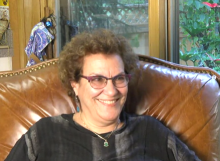
Grew up in the Bronx and attended Marymount Manhattan College.
Ana Luisa Cardona was born on June 11, 1950 in the Bronx, NY. Her Puerto Rican parents raised Cardona with her brother in a traditionally Jewish neighborhood that slowly evolved to a multi-ethnic minority space. In elementary school, Cardona was placed in a special education class and tracked into lower ability-level classes because she was shy, but she soon grew out of her shyness thanks to dance classes. Her mother ensured that Cardona’s first language was English and that Cardona had access to equitable education by enrolling her in parochial school.
In her all-female high school, Cardona pursued the academic track and, while she was successful academically, she was also frustrated by the fact that the arts were treated as “extracurricular.” In spite of her great high school experience, Cardona realized there were many different walks of life outside of the Bronx. In college, Cardona commuted to classes at Marymount Manhattan College, extending the time in what she calls her “gilded cage.” During her first trip abroad, to study in Spain during the Francisco Franco regime, Cardona joined a politically motivated theatre group, which was her first taste of activism and initiated her political awakening. Following her trip abroad, and her graduation with a BA in Studio Art and Art History from Marymount Manhattan College, Cardona left New York for the University of Michigan, where she pursued graduate studies in Art History.
At Michigan, Cardona soon found the Chicano Advocates Office and met activists Jesse Gonzalez and Julio Perazza. Together, they began the Raza Art and Media Collective. Through the Raza Art and Media Collective, Cardona recruited many Californian Chicanos, Tejanos, New Mexicans, and Puerto Ricans. Cardona enjoyed working with Chicano artists and the vibrant Chicano art scene, and eventually she became more engaged by the art she was learning about outside of her Master’s program than she was with the more traditional art history she was learning in her classes. Nevertheless, she still managed to earn Master’s degrees in History of Art and Instructional Technology from the University of Michigan. After completing her course of study, Cardona traveled to Puerto Rico with Julio Perazza to photograph subjects and record oral histories for a project called “Los Viejitos.” Cardona was also essential in the activities of Casa de Unidad in Detroit in the late 1970s.
In 1977, Cardona received a fellowship to work at the National Endowment for the Arts in D.C where she provided administrative support to the Hispanic task force. While in Washington, Cardona became pregnant with her son, Simón, and her partner, Julio Perazza, moved from Michigan to D.C. to work at the Library of Congress. Cardona returned to Puerto Rico in 1980 for a trip with her family and conducted an oral history of Jack Delano, who was the head of the Division of Community Education in the 1950s. When she returned to Michigan, she found a position in the College of Education’s Office of Minority Affairs at the University of Michigan and Jack Delano continued to be a solid artist-mentor for Cardona. Eventually, Cardona took a position at the Michigan Department of Education, where she worked from 1987 to 2011. She is a longstanding activist for equity and art in education and has devoted 23 years in multiple leadership positions. She continues to provide leadership in arts education at the state and national levels.
